Samburu National Reserve in northern Kenya is famous for its “Samburu Special Five”. Five rare species found only in this north of equator region: Grevy’s zebra, Somali ostrich, reticulated giraffe, gerenuk, and Beisa oryx. Spanning 165 km², the reserve offers a unique, less-crowded safari experience with stunning landscapes shaped by the Ewaso Ng’iro River, which is vital for wildlife survival.
Key Highlights:
- Special Wildlife: Nearly 90% of the world’s Grevy’s zebra population lives here.
- Birdwatching: Over 450 bird species recorded.
- Access: 5–6 hours by road or a 1-hour flight from Nairobi.
- Seasons: Best time to visit is during the dry months (June–October, December–March).
- Astro Tourism Experiences
Quick Facts About the Samburu Special Five:
- Grevy’s Zebra: Largest zebra species, known for narrow stripes and large ears.
- Somali Ostrich: Recognizable by its blue neck and legs.
- Reticulated Giraffe: Features a striking net-like coat pattern.
- Gerenuk: Stands on hind legs to feed on tall shrubs.
- Beisa Oryx: Adapted to arid environments with long, straight horns.
The reserve is also home to Kamunyak, a lioness famous for adopting oryx calves, showcasing the area’s remarkable wildlife stories. Conservation efforts here focus on protecting endangered species and mitigating challenges like water scarcity and human-wildlife conflict.
Want to visit? Wild Springs Adventures offer expert-guided safaris that support conservation while giving you the chance to see these rare animals up close.
Amazing Wildlife Safari in Samburu and Buffalo Springs National Reserve | Kenya 2020 | 4K-Video
The Samburu Special Five: Animals Found Only Here
The Samburu Special Five are a group of extraordinary animals that have adapted to survive in the tough, semi-arid environment of northern Kenya. These five species – Grevy’s zebra, Somali ostrich, reticulated giraffe, gerenuk, and Beisa oryx – stand out for their unique traits and survival strategies, making them a highlight of any visit to Samburu.
“Known for more than just its big herds of elephant, prides of lion and leopard, Samburuland has its own ‘Special Five’ lurking in the dry bush: Grevy’s zebra, long-necked gerenuk, reticulated giraffe, Somali ostrich and Beisa oryx.” – Wild Springs Adventures
Let’s dive into what makes each of these species so remarkable, along with tips for spotting them and the challenges they face.
Grevy’s Zebra: Samburu Special Five
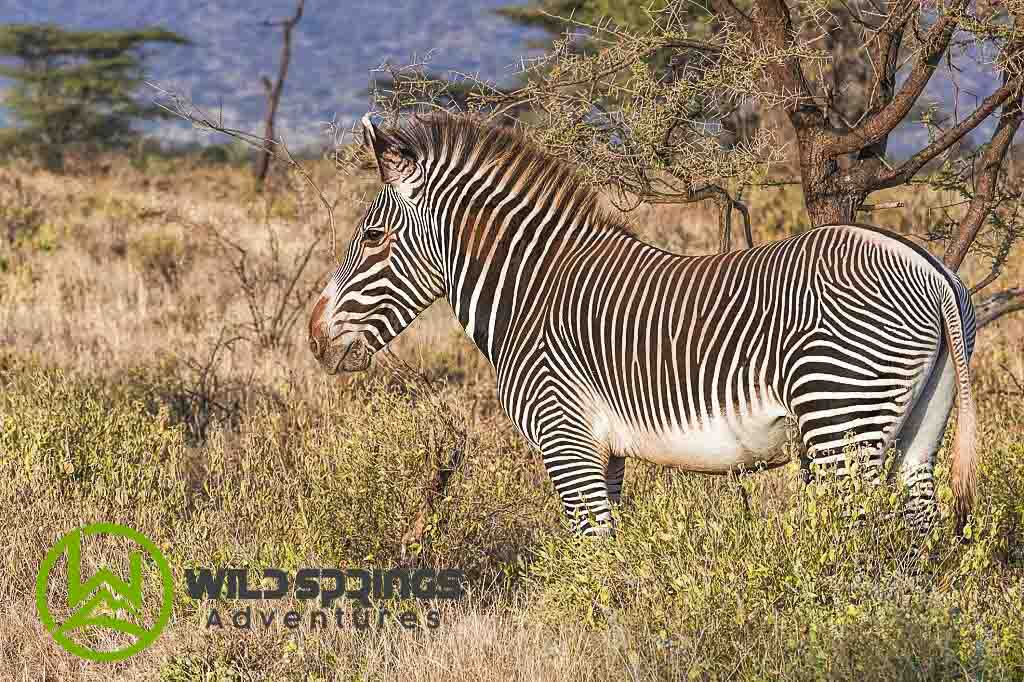
The Grevy’s zebra is not just any zebra – it’s the largest of its kind. Males can weigh up to 948 pounds (430 kg) and are easily recognized by their narrow black-and-white stripes that stop at the belly, along with their large, rounded ears. Unlike the more social plains zebra, Grevy’s zebras are often solitary.
With only about 3,000 individuals left worldwide, Kenya is home to nearly 90% of the population, making Samburu a critical sanctuary for their survival. If you’re visiting during the dry season (June–October and December–March), head to the Ewaso Ng’iro River early in the morning or late afternoon for the best chance to see them.
Somali Ostrich-Samburu Special Five
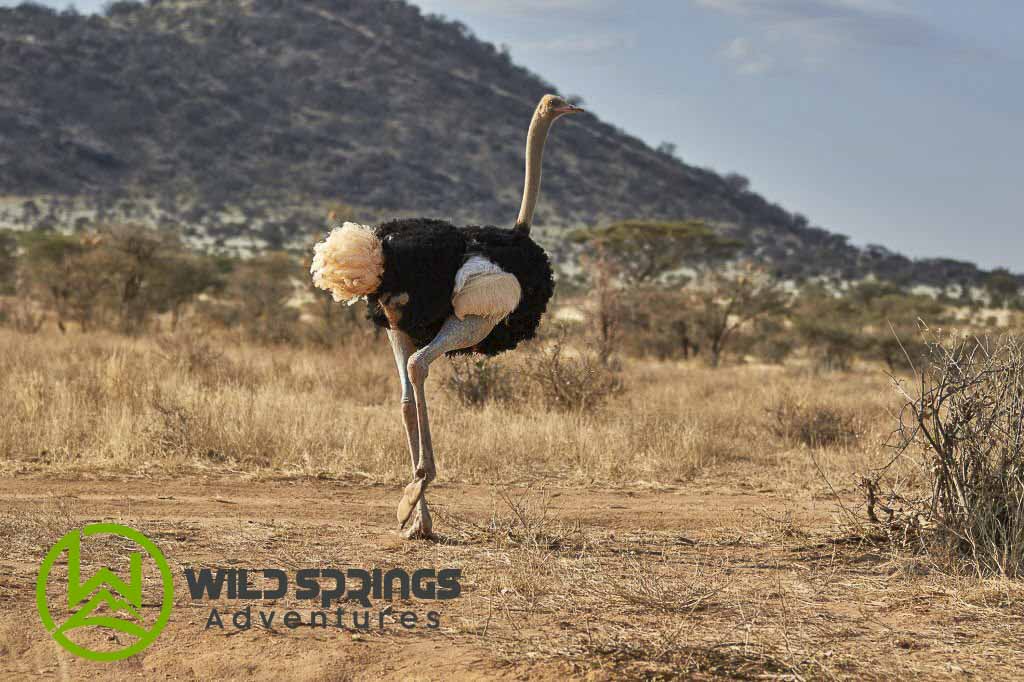
Adding a splash of color to Samburu’s landscape is the Somali ostrich. Males are particularly striking with their bright blue necks and legs, which stand in sharp contrast to the pink necks of common ostriches. Their feathers also differ: males sport bold black-and-white plumage, while females, slightly larger, are dressed in muted grayish-brown tones.
Though flightless, Somali ostriches are built for speed, capable of running up to 43 mph (70 km/h). They favor the open grasslands and semi-arid areas of Samburu, making them a regular sight during morning and evening game drives.
Reticulated Giraffe
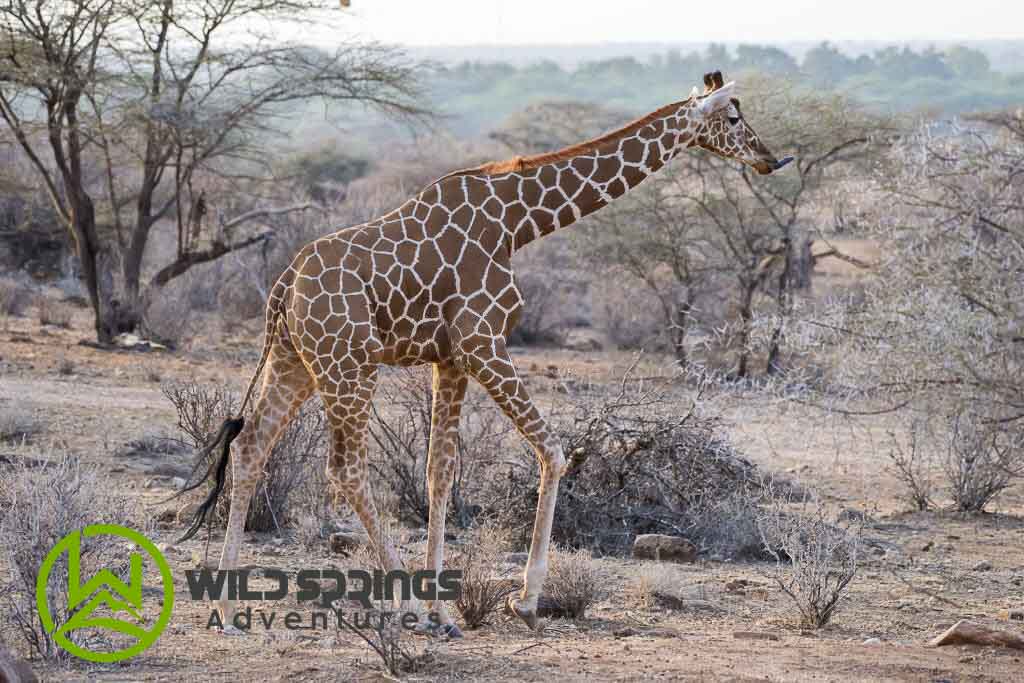
The reticulated giraffe is a showstopper with its stunning coat of large, polygonal patches outlined in bright white, creating a net-like pattern. As the world’s tallest land animal, it’s hard to miss these graceful creatures, though they are slightly shorter than their Masai giraffe cousins found in southern Kenya.
Sadly, with fewer than 16,000 individuals left in the wild, their numbers are dwindling due to habitat loss and human activity. To spot them, look for acacia woodlands near the Ewaso Ng’iro River, where their towering presence is hard to overlook.
Gerenuk-Samburu Special Five
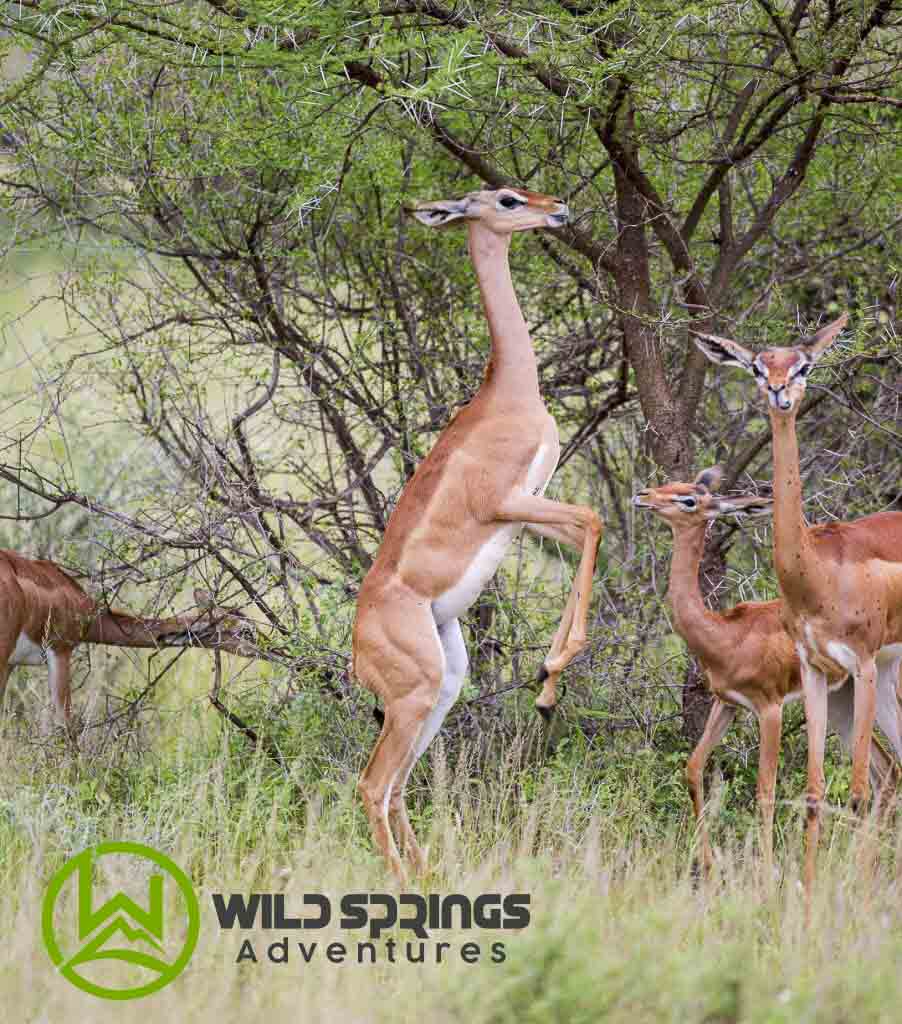
The gerenuk, often called the “giraffe gazelle”, is famous for its ability to stand upright on its hind legs to reach leaves high above the ground. This unique feeding behavior, combined with their long necks, slender legs, and small heads, makes them perfectly suited to Samburu’s dry bushlands.
Males are larger, weighing between 66–132 pounds (30–60 kg), and are easily identified by their lyre-shaped horns, while females are slightly smaller at 44–110 pounds (20–50 kg). Their alert eyes and ears make them a fascinating species to observe. Explore more antelopes to spot during a Kenya safari.
Beisa Oryx: Samburu Special Five
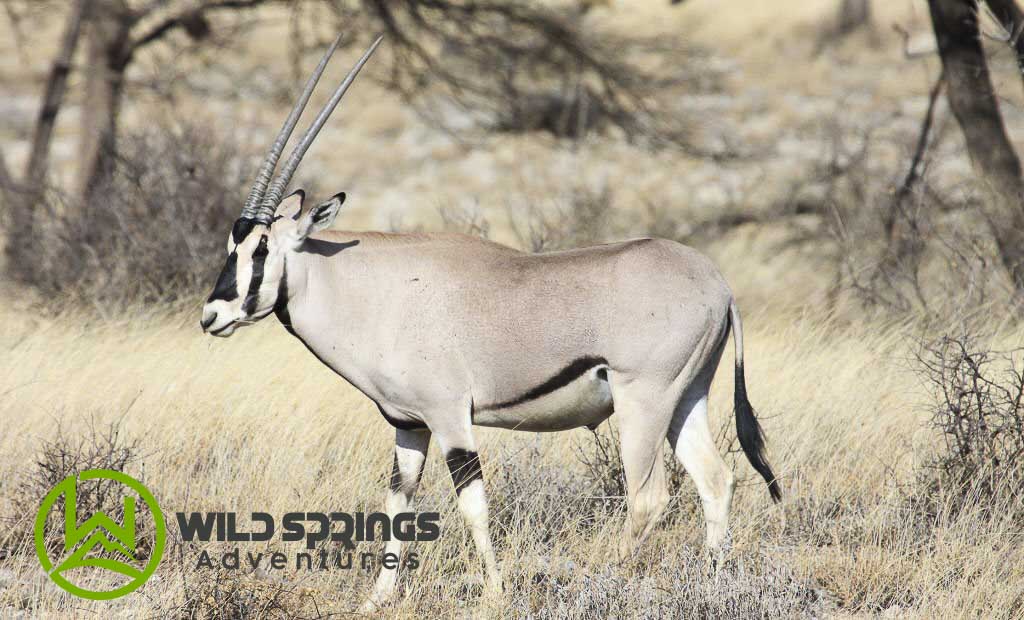
The Beisa oryx is a master of survival in arid landscapes. Both males and females have long, straight horns that can reach 30–31 inches (75–80 cm) in length. Their gray-brown coat, accented with bold black-and-white facial markings and a black stripe along their flanks, sets them apart from other antelopes.
These animals have an incredible ability to conserve water, even raising their body temperature to minimize sweating. During the dry season, they often gather near scarce water sources, making them easier to spot during game drives.
Protecting the Samburu Special Five is vital. Their survival not only ensures the continuation of these extraordinary species but also helps maintain the delicate balance of Samburu’s unique ecosystem, which has evolved over countless years.
The Story of Kamunyak: The Lioness Who Adopted an Oryx Calf
Deep in the Samburu National Reserve lies a tale that defies everything we think we know about predator-prey relationships. This is the extraordinary story of Kamunyak, a lioness whose maternal instincts broke all the rules of nature.
Facts About Kamunyak
On December 21, 2001, wildlife officials spotted a young lioness, estimated to be around 2–3 years old, caring for a newborn oryx calf. She was named “Kamunyak”, which translates to “the blessed one” or “the miracle one” in the local Samburu language.
What made Kamunyak’s behavior so astonishing was her refusal to hunt the calf. Instead, she protected it fiercely, even defending it from other predators. In an even more surprising twist, Kamunyak allowed the calf’s biological mother to nurse it, showcasing a level of care and cooperation that baffled experts.
“She must have adopted her on Sunday because they are in harmony.” – Gabriel Lepariyo, wildlife service warden
Kamunyak’s compassion didn’t stop there. Over the next few years, she adopted at least six more oryx calves. Reports suggest she gave up hunting altogether after her first adoption. Unfortunately, not all her efforts ended happily. One of the calves was killed by a male lion, a stark reminder of the risks she faced in her unconventional role. Kamunyak continued her adoptions until her last recorded sighting in February 2004.
Impact on Conservation Awareness
Kamunyak’s actions sparked a global conversation about the complexities of animal behavior, maternal instincts, and the connections between species. Her story was a first in the world of wildlife observation, leaving experts scratching their heads. She became a symbol of Samburu’s unique wildlife, and her story highlighted the mysteries that nature still holds. Conservationist Daphne Sheldrick remarked:
“Lions, like all the other species, including human beings, have this kind of feelings for babies”.
Kamunyak’s tale also underscored the importance of preserving wild habitats where such extraordinary events can take place. Her story became a rallying cry for conservation efforts in Samburu, reminding us of the delicate balance that exists in the natural world.
Local and Global Reactions
Kamunyak’s story quickly captured the attention of both local communities and the global media. Documentary filmmakers like Saba and Dudu Douglas-Hamilton traveled to Samburu to document her unusual behavior. Major outlets, including BBC News and The Guardian, brought her story to an international audience, shining a spotlight on Samburu National Reserve.
Locally, the reactions were just as intense. The warden of Samburu Reserve faced pressure to intervene and feed Kamunyak during her period of not hunting. Chief Game Warden Simon Leirana admitted:
“We are baffled. We do not know what to do with this third oryx”.
For some Kenyans, Kamunyak’s actions were seen as divine signs. With interpretations ranging from “god has arrived” to “the world is ending”. Religious leaders even called it “the end of the age”, and many described it as the “eighth wonder of the world”. Meanwhile, Samburu nomadic pastoralists viewed the events through the lens of their own legends and understanding of animal behavior.
Kamunyak’s legacy remains one of the most extraordinary moments in Samburu’s history. Her story continues to inspire visitors and conservationists alike. Serving as a powerful reminder of the importance of protecting fragile ecosystems. Kamunyak’s remarkable journey is a testament to the wonders of nature and the urgent need to preserve it for future generations.
Conservation in Samburu: Challenges and Efforts
Kamunyak’s incredible story highlights the beauty of Samburu, but this rugged region faces significant challenges that threaten its wildlife. The very landscapes that make Samburu National Reserve a haven for the Special Five also bring a host of conservation pressures.
Current Conservation Challenges
Water scarcity is a critical issue for Samburu’s ecosystem. A devastating drought in 2009 led to the deaths of thousands of animals, including a severe blow to the buffalo population.
“This prolonged drought has led to cascading threats for all life in the region.” – Wildlife Conservation Network
Periods of drought also intensify human-wildlife conflict, as both people and animals compete for limited water sources. In 2017, this conflict resulted in the loss of five lions.
Habitat loss poses another threat, particularly for the Special Five. These species, uniquely adapted to Samburu’s arid environment, are losing ground. For example, the Grevy’s zebra, with fewer than 3,000 individuals left worldwide, faces an increasingly uncertain future.
Adding to these challenges are inter-community conflicts over natural resources. Livestock raids and disputes over grazing land account for 35.6% of these conflicts, which, according to 30.5% of respondents in a local survey, negatively impact wildlife by reducing species diversity.
Finally, climate change worsens these issues. More frequent and severe droughts disrupt migration patterns, endangering both the ecosystem and the survival of the Samburu Special Five.
Despite these pressing challenges, conservation organizations are stepping up with creative strategies to protect Samburu’s unique wildlife.
Efforts by Conservation Organizations
Amid these difficulties, several groups are working tirelessly to make a difference.
Save the Elephants (STE) has been at the forefront of elephant conservation since its founding in 1993. Based in Nairobi, with a research station in Samburu National Reserve, STE uses radio and GPS tracking to monitor elephant movements and protect herds from poachers. Thanks to their collaboration with the Kenya Wildlife Service, elephant poaching has dropped significantly over the past decade.
“STE’s mission is to secure a future for elephants and sustain the beauty and ecological integrity of the places they live, to promote man’s delight in their intelligence and the diversity of their world, and to develop a tolerant relationship between the two species.” – Save the Elephants
In addition, STE co-founded the Elephant Crisis Fund in 2013, which has supported 415 projects across 44 countries in Africa and Asia.
Grevy’s Zebra Trust (GZT)
Grevy’s Zebra Trust (GZT) focuses on saving one of the world’s most endangered zebra species. Their work includes population surveys, habitat protection, and disease monitoring. During droughts, GZT provides supplementary hay to sustain the Grevy’s zebra, with local community members helping monitor feeding sites.
Ewaso Lions studies lion movements and their interactions with livestock. Their “Mama Simba” program trains Samburu women as conservation ambassadors, empowering them to protect lions and other carnivores.
The Northern Rangelands Trust (NRT) oversees 35 community conservancies in northern Kenya, including areas near Samburu National Reserve. By creating wildlife corridors, NRT supports species migration and maintains genetic diversity.
Other efforts include the Giraffe Conservation Foundation. Which uses tracking and collaring to study giraffe movements and prevent poaching. Also, the Lion Guardians Program, which works with local warriors to protect big cats and reduce human-predator conflicts.
During crises, organizations like GZT and Ewaso Lions collaborate to provide water for both communities and livestock. Strengthening local support for conservation.
How Tourism Supports Conservation: Samburu Special Five
Responsible tourism plays a crucial role in funding conservation initiatives while providing economic benefits to local communities. With 65% of Kenya’s wildlife living outside government-protected areas, community-based conservation is essential.
Tourism revenue directly funds conservation projects. Eco-lodges, for example, reinvest profits into wildlife protection and community development. Across Kenya, over 160 community conservancies spanning millions of acres showcase the impact of tourism-supported conservation.
Local employment is another benefit. At Lewa Wildlife Conservancy, 90% of staff are hired from nearby communities, ensuring that conservation efforts directly benefit local people.
Sera Wildlife Conservancy, part of the Northern Rangelands Trust. It is a prime example of how tourism and conservation go hand in hand. Revenue from tourism funds essential projects like boreholes and water pipelines, as well as education and infrastructure initiatives. Managed grazing systems also help prevent overuse of resources.
Segera Retreat offers another inspiring model. This eco-tourism venture empowers local women through conservation efforts, including a female ranger program. It also supports local artisans, schools, and community projects, providing education and career opportunities.
Tourism revenue and challenges in Samburu
Tourism revenue doesn’t just protect wildlife – it also improves community well-being. Funding for mobile clinics and clean water projects enhances the quality of life for those living near conservation areas.
“Conservation can’t succeed in isolation – neither ecological nor social.” – Llew Dyer, Borana Conservancy
“Meaningful community engagement forms the backbone of lasting conservation. When local voices lead and benefit from conservation initiatives, transformation happens at a scale no outside effort could achieve alone.” – Jeremiah Mutisya, CEO Saruni Basecamp
The challenges in Samburu are undeniable, but the combined efforts of conservation organizations, local communities, and ethical tourism offer a path forward. Every visitor who supports conservation-focused accommodations and tour operators contributes to preserving Samburu’s extraordinary wildlife and landscapes. These collaborative efforts lay the foundation for unforgettable safaris with Wild Springs Adventures.
Wild Springs Adventures: Expert Safaris in Samburu

After exploring the conservation efforts safeguarding Samburu’s extraordinary wildlife, you might be wondering how to experience these majestic creatures responsibly. That’s where Wild Springs Adventures steps in, offering safaris that not only showcase the Samburu Special Five but also actively support the conservation initiatives you’ve just read about. Every safari we organize reflects our deep commitment to these values.
About Wild Springs Adventures
Headquartered in Nairobi, Wild Springs Adventures brings together seasoned tour professionals dedicated to creating unforgettable journeys through Kenya’s stunning landscapes. Our mission is to forge meaningful connections between travelers and the natural beauty of Kenya.
With a stellar 5.0 rating on TripAdvisor from 107 reviews and a 98% recommendation rate, Wild Springs Adventures has earned the trust of countless travelers. Our expertise in Samburu National Reserve is unmatched, offering experiences like the 3 Days 2 Nights Samburu National Reserve Safari designed to maximize sightings of the Special Five. Their intimate knowledge of the region ensures guests have the best chance to encounter Grevy’s zebras, reticulated giraffes, and other rare species.
“Our focus is on creating life-changing connections that cross cultures, generations, and continents.” – Wild Springs Adventures
Expert Team and Personalized Tours
Wild Springs Adventures doesn’t believe in cookie-cutter safaris. Instead, we tailor each tour to highlight the unique wonders of Kenya. Our team includes expert wildlife interpreters and trekking guides, bringing years of hands-on experience to every adventure.
This personalized approach is reflected in glowing client reviews. For instance, in September 2024, a family of six entrusted Wild Springs Adventures with planning a safari tailored to young children. They praised the team for their thoughtful planning and exceptional service.
Zack C, a repeat traveler, shared his experience from April 2025, emphasizing the team’s expertise:
“They are kind, knowledgeable, and will work with you to create the best experience for you they can. They are willing and able to answer all the questions you may have about the wildlife, and go out of their way to make it great!” – Zack C, TripAdvisor Reviewer
Wild Springs Adventures goes beyond traditional game drives. Recent guests reported remarkable encounters with a wide variety of wildlife, including white and black rhinos, lions, Cape buffalo, elephants, baboons, hyenas, and an array of bird species. Our guides don’t just point out animals – they bring the wilderness to life. As the company describes one of their standout guides:
“Tim isn’t just your guide; he’s an interpreter of the wild. With a keen eye and deep knowledge of the African bush, Tim brings the wonders of wildlife to life.” – Wild Springs Adventures
This level of expertise is particularly valuable when tracking the elusive Samburu Special Five, as guides understand the behaviors, habitats, and timing that lead to unforgettable wildlife encounters.
Commitment to Conservation and Community
Wild Springs Adventures combines expert guidance with a strong dedication to conservation. Their eco-conscious practices ensure that every safari supports Samburu’s delicate ecosystem.
Over the years, they’ve cultivated relationships with local suppliers to provide authentic yet affordable experiences. These partnerships extend to community conservancies like West Gate, Kalama, and Namunyak, which play a crucial role in protecting the region’s unique biodiversity.
By choosing Wild Springs Adventures, travelers directly contribute to conservation efforts. Safari fees help fund programs that protect species like the Grevy’s zebra and reticulated giraffe. The company also supports community-led initiatives that promote sustainable livelihoods, reduce human-wildlife conflict, and enhance eco-tourism.
The connection between conservation and the local Samburu people is central to their approach. Wild Springs Adventures recognizes that the success of conservation depends on the active involvement of these communities, who coexist with wildlife and play a vital role in its protection.
Leslie G, a loyal client who has toured Kenya with Wild Springs Adventures three times, most recently in April 2025, praised their consistent quality:
“All experiences were top notch. I highly recommend them.” – Leslie G, TripAdvisor Reviewer
This kind of repeat business speaks volumes about their dedication to maintaining high standards. When you book with Wild Springs Adventures, you’re not just securing a once-in-a-lifetime safari – you’re actively supporting the preservation of Samburu’s incredible wildlife for generations to come.
Conclusion
Samburu National Reserve is a wildlife haven, shaped by the life-giving waters of the Ewaso Ng’iro River. This remarkable reserve is home to rare and distinctive species, making it a sanctuary for some of Africa’s most extraordinary animals.
What sets Samburu apart is its tranquil, less-crowded safari experience. Unlike Kenya’s busier parks, Samburu offers visitors the chance to connect with nature in a peaceful setting, undisturbed by large tourist groups. The lush riverine forests along the Ewaso Ng’iro River not only create a stunning backdrop but also support an impressive array of wildlife, including over 450 bird species and more than 900 elephants.
Gravy Zebra Trust: Conservation Stories.
Conservation plays a vital role here. Organizations like the Grevy’s Zebra Trust and Save the Elephants are actively working to protect endangered species and mitigate human–wildlife conflicts. From employing local scouts to using GPS collars for tracking migration, these efforts are integral to maintaining the delicate balance of this ecosystem. Wild Springs Adventures, known for its expertise in safari experiences, also contributes to these conservation initiatives.
“Visiting Samburu National Reserve is a truly enriching experience that combines unique wildlife sightings, breathtaking landscapes, and immersive cultural encounters.” – samburureserve.org
To make the most of your trip, consider visiting during the dry months – June to October or December to March – when animals gather around water sources, offering exceptional wildlife viewing opportunities. For a different perspective, try a camel safari or a walking safari, both of which provide a closer connection to the stunning landscape.
By booking a tour with Wild Springs Adventures, you’re directly supporting conservation efforts. Their perfect 5.0 rating on TripAdvisor, based on 107 reviews, highlights their dedication to protecting wildlife while providing unforgettable safari experiences.
A visit to Samburu National Reserve offers not just incredible wildlife encounters but also the chance to contribute to vital conservation work in one of Kenya’s most untouched wilderness areas.
FAQs
What makes the Samburu Special Five stand out from other wildlife in Kenya?
The Samburu Special Five refers to a group of rare animals that call the Samburu region of Kenya home. This extraordinary lineup includes the Grevy’s zebra, Somali ostrich, reticulated giraffe, gerenuk, and Beisa oryx. Each of these species has uniquely adapted to thrive in the dry, rugged terrain of the Samburu National Reserve, making them a highlight for anyone passionate about wildlife.
What makes these animals even more captivating is their limited range – you won’t find them in most other Kenyan reserves. Seeing these remarkable creatures in their natural environment is an unforgettable experience that sets Samburu apart as a must-visit destination for nature lovers.
How does Samburu National Reserve address water shortages and human-wildlife conflicts?
Samburu National Reserve: Addressing Water Shortages and Human-Wildlife Conflicts
Samburu National Reserve is tackling two pressing challenges – water scarcity and human-wildlife conflicts – through carefully planned conservation strategies that aim to balance the needs of the environment with those of local communities. One of the key approaches involves sustainable water management programs, which include drought relief efforts. These initiatives ensure that both wildlife and nearby residents have access to water, reducing competition and preventing animals from wandering into human settlements in search of resources.
Another crucial element is the active involvement of local communities in resolving conflicts. By blending traditional knowledge with modern methods, they work to ease tensions between people and wildlife. This collaborative approach is vital for protecting the reserve’s unique ecosystem while also improving the quality of life for the communities living around it.
Why should I choose Wild Springs Adventures for a safari, especially in terms of conservation and wildlife experiences?
Choosing Wild Springs Adventures for your safari means making a choice that supports wildlife and the planet. Our tours are designed with a focus on preserving natural habitats and safeguarding endangered species, ensuring your visit leaves a positive mark on the environment.
But that’s not all. Wild Springs Adventures partners with local communities to promote responsible tourism. By working hand-in-hand with residents, they raise awareness and encourage community involvement, creating lasting benefits for both the environment and the people who call it home. This approach not only enriches your wildlife adventure but also helps protect these stunning ecosystems for generations to come.
